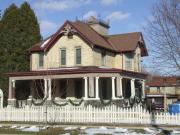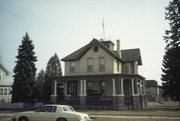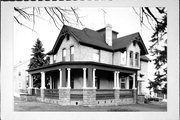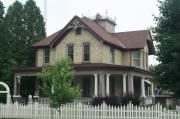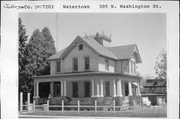Property Record
305 N WASHINGTON ST
Architecture and History Inventory
| Historic Name: | William Hartig House |
|---|---|
| Other Name: | |
| Contributing: | Yes |
| Reference Number: | 7202 |
| Location (Address): | 305 N WASHINGTON ST |
|---|---|
| County: | Jefferson |
| City: | Watertown |
| Township/Village: | |
| Unincorporated Community: | |
| Town: | |
| Range: | |
| Direction: | |
| Section: | |
| Quarter Section: | |
| Quarter/Quarter Section: |
| Year Built: | 1890 |
|---|---|
| Additions: | |
| Survey Date: | 19862004 |
| Historic Use: | house |
| Architectural Style: | Queen Anne |
| Structural System: | |
| Wall Material: | Cream Brick |
| Architect: | |
| Other Buildings On Site: | |
| Demolished?: | No |
| Demolished Date: |
| National/State Register Listing Name: | North Washington Street Historic District |
|---|---|
| National Register Listing Date: | 10/23/2009 |
| State Register Listing Date: | 4/17/2009 |
| National Register Multiple Property Name: |
| Additional Information: | This was the most significant residence of William Hartig, the largest and most successful brewer in Watertown's history. He lived here between c. 1880s and c. 1921. The Hartig Brewery had its beginnings in 1847 as the John Hoeffner brewery, the first official beer brewery in the community. In 1854 Hoeffner sold his brewery to Joseph Bursinger, who named it the City Brewery. In 1883 Bursinger went bakrupt and the brewery was sold to William Hartig and Charles Manz. In 1896 Manz sold out his share of the business, and the brewery became the William Hartig Brewing Company. In 1897, Hartig acquired the physical plant of the Fuermann Brewery, which he used as a malt house until it burned in the early twentieth century. In 1921 Hartig closed for prohibition and the factory manufactured near beer and ice cream for 10 years. In 1931 it reopened but was sold in 1945. The new owners went bankrupt in 1947 and in 1953 the brewery was demolished for a supermarket. Brewing was an important historical industry in the community with its large German population providing both skilled workers and consumers. Due to economic changes in the twentieth century and the effect of prohibition, like many other communities, Watertown has lost all of its breweries. The Hartig Brewery was the most successful of the historic breweries, eventually consolidating facilities with the other large brewery in the community, the Fuermann Brewery. William Hartig was the most important owner of the Hartig Brewery and is, therefore, the most significant person assocaited with this brewery and all breweries in town. This house, which was Hartig's home during his more successful years in the brewing business, is significant because of its association with him, especially since none of the industrial resources related to Hartig are still extant. Exhibiting the most common roof type of the Queen Anne style, the 1880s William Hartig house features a hipped roof with lower cross gables projecting at the front, sides, and rear and with a flat 12 foot square wall encircled with iron railings placed directly to the rear of the peak of the main hip roof. Bargeboards and gable ornament decorate the gable ends and raised brick Italianate segmental arched window hoods with corbelled ends decorate the long windows. A cut away two-story bay characterizes the south gabled wing. Featuring dentil trimmed eaves and classical Ionic columns placed on tall masonry bases and balustrade, the open, flat roofed wrap around porch was probably added to the house at the turn of the century. The entrance has a sidelighted door with transom window. Dominated by the Queen Anne roof type and irregularity of form as well as the Gothic Revival treatment of the gables found in the early examples of the Queen Anne style, the Hartig house shows the Italianate influence basically in the articulated arched window design. The classical influence was added by the turn of the century addition of the Ionic columns on the front porch. One of the few good brick examples of the Queen Anne style remaining in the city, the Hartig house can be compared with two other significant examples of the Queen Anne style in the city constructed in brick at 512 So. 5th (41/21), 600 Clyman (43/20), 600 So. 3rd (42/8) and 400 No. Washington (22/21). Carriage house (55/31) - separate record. |
|---|---|
| Bibliographic References: | (A) Evelyn Ruddick Rose, Our Heritage of Homes (Watertown Historical Society, 1980), pp. 29-30. (B) Watertown City Directories, 1866-1930, Watertown Public Library. (C) William F. Jannke III, "Watertown Brewing History," Unpubclished data on breweries compiled from Watertown's historic newspapers. Copy on file at the Watertown Historical Society, Octagon House, Watertown, Wisconsin and with author. “Architecture/History Survey: Reconstruct STH 26 (Church St.): STH 19 To Union Pacific RR.” WHS project number 04-0759/DO/JE. February 2004. Prepared by Carol Cartwright. |
| Wisconsin Architecture and History Inventory, State Historic Preservation Office, Wisconsin Historical Society, Madison, Wisconsin |

